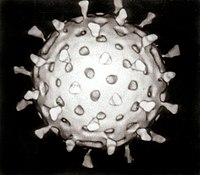
Photo from wikipedia
Interspecies transmission is an important mechanism of evolution and contributes to rotavirus A (RVA) diversity. In order to evaluate the detection frequency, genetic diversity, epidemiological characteristics and zoonotic potential of… Click to show full abstract
Interspecies transmission is an important mechanism of evolution and contributes to rotavirus A (RVA) diversity. In order to evaluate the detection frequency, genetic diversity, epidemiological characteristics and zoonotic potential of RVA strains in faecal specimens from humans and animals cohabiting in the same environment in the department of Cusco, Peru, by molecular analysis, 265 faecal specimens were obtained from alpacas, llamas, sheep and shepherd children, and tested for RVA by RT-PCR. Genotyping was performed by multiplex PCR and sequence analysis. Rotavirus A was detected in 20.3% of alpaca, 47.5% of llama, 100% of sheep and 33.3% of human samples. The most common genetic constellations were G3-P[40]-I8-E3-H6 in alpacas, G1/G3-P[8]-I1-E1-H1 in llamas, G1/G3/G35-P[1]/P[8]-I1-E1-H1 in sheep and G3-P[40]-I1/I8-E3-H1 in humans. The newly described genotypes P[40] and P[50] were identified in all host species, including humans. Genotyping showed that the majority of samples presented coinfection with two or more RVA strains. These data demonstrate the great genetic diversity of RVA in animals and humans in Cusco, Peru. Phylogenetic analysis suggested that the strains represent zoonotic transmission among the species studied. Due to the characteristics of the human and animal populations in this study (cohabitation of different host species in conditions of poor sanitation and hygiene), the occurrence of zoonoses is a real possibility.
Journal Title: Transboundary and emerging diseases
Year Published: 2019
Link to full text (if available)
Share on Social Media: Sign Up to like & get
recommendations!